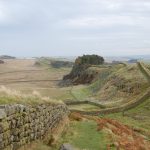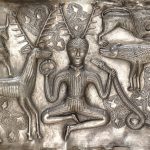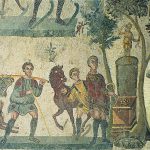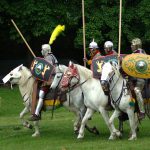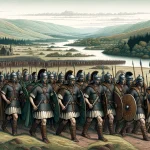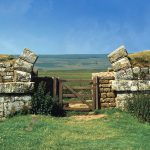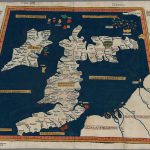Parton (Gabrosentum) Roman Fort
Hadrianic Auxiliary Fort (117 to 138)
Roman fort possibly the site of Tunocelum or Gabrosentum is visible as an earthwork on air photographs. The fort measures 358ft N-S by 400ft E-W and is circa 3.5 acres in extent (b), the E-W measurement and acreage confirmed by Birley.
The Gabrosentum Fort
Two altars and six inscribed stones were found in and around the fort, one of which had a Hadrianic inscription, suggesting 128-138 AD as the construction date of the fort.
RIB 801 - Inscription
(This work) of the Emperor Caesar Trajan Hadrian Augustus, father of his country, the Twentieth Legion Valeria Victrix (built).
TRAIAN HADRI
ANI AVG P P
LEG XX V V
1. For this interpretation see note to RIB 1638. 3. As Hadrian became pater patriae in A.D. 128, this inscription is dated to A.D. 128-38.Bennett notes some instances of Hadrian pater patriae before a.d. 128, but they remain exceptional.
RIB 800 - Inscription
… under the charge of Valerius Lupercus, prefect of the Second Cohort of Lingonians.
CVRAN VALERIO
LVP[...]RCO PRAEF
COH II LING
Birley considers that this prefect may have been a kinsman of the senator Q. Valerius Lupercus Julius Frontinus, attested by two inscriptions from Vienne (PIR¹ iii, V no. 70).
RIB 803 - Building inscription of the Second Cohort of Thracians
The Second Cohort of Thracians built this.
TRAQ FEC
No commentary.
RIB 802 - Fragmentary inscription
The seventh cohort (built this).
If the text is complete, it records work done by the seventh cohort of a legion, presumably the Twentieth (see RIB 801, and Birley loc. cit.).
The Garrison Units
RIB 798 - Altar dedicated to Silvanus
To the god Silvanus the Second Cohort of Lingonians, under the command of Gaius Pompeius Saturninus, son of Marcus, (set this up).
COH II LING[...]
CVI PRAEES[...]
G POMPEIVS M [...]
SATVRNIN[...]
Camden mentions ‘this altar … with a little horned image representing Sylvanus’ (trans. by Philemon Holland, p. 766). Huebner regards this image as a carving on the stone, as did Holland. Birley interprets it as a separate object R.P.W.
Cohors Secundae Lingonum is recorded in stone on two undated inscriptions recovered from Moresby, a building inscription (vide RIB 800) and an altar to Silvanus (RIB 798 supra). The Second Cohort of Lingones were a part-mounted unit numbering five-hundred men, levied from the Lingones tribe of Upper Germany, now the Dijon region of France. They are also attested on stamped tiles and an undated altar (Rib 635) at Ilkley in Yorkshire, and were possibly the original Hadrianic garrison here, at Gabrosentum.
RIB 804 - Funerary inscription for Smertrius
To the spirits of the departed and to Smert[ri]us, son of Macer, soldier of the Second Cohort of Thracians, part-mounted, of ten years’ service he lived 35 years, 5 days.
SMERT[...]
O MAC[... ]
M COH I[...]
[...]HRAC[...]
[...]Q STIP
X VICSIT [...]
XXXV D V
No commentary.
The Notitia Dignitatum Entry
“The tribune of the Second Cohort of Thracians at Gabrosentis“
Like its predecessor this unit was part-mounted and contained a nominal five-hundred men, this time recruited from amongst the various tribes of Thracia province, inhabiting the area between the Ægean and Black Seas, a region which encompassed modern southern Bulgaria, eastern Macedonia and Turkey west of the Bosporous.
The Gods of Roman Moresby
RIB 797 - Dedication to Jupiter Optimus Maximus
To Jupiter, Best and Greatest, the Second Cohort of Thracians, part mounted, under the command of its prefect Mamius Nepos, (set this up).
COH II TRA
EQ C P MAMI
VS NEPOS PRA
EF
For the nomen Mamius see CIL ix 1538 (ILS 4185) Beneventum.
RIB 799 - Fragmentary dedication.
… to mark the success in building the gable.
RITATEM
CVLMINIS
INSTITVTI
No commentary.
RIB 805 - Fragmentary inscription
…Lucius Severinus, centurion ..
‘ordinatus occurs sporadically in the second and third centuries in substitution for centurio on inscriptions relating to auxiliary cohorts’ Birley.On the stone the words were probably in the nominative, but Camden’s construction places them in the accusative (Birley). Fleming uses the nominative R.P.W.
Classical References for Gabrosentvm
The name of the Roman station at Moresby is mentioned in two classical geographical sources; the Notitia Dignitatum, where it appears as Gabrosentum; also in the Ravenna Cosmology (R&C#117), where it is listed as Gabrocentium, between the unidentified Iuliocenon entry and Alauna (Maryport, Cumbria).
The modern name for the site first appears in a document dating c.1160AD where it is recorded as Moresceby, which means ‘the Village of Maurice’, a mixture of an Old French personal name and the Scandinavian suffix -by, which indicates a large farm or small village.
References for Gabrosentvm
- The Roman Inscriptions of Britain by R.G. Collingwood and R.P. Wright (Oxford 1965);
Roman Roads near Gabrosentvm
Probable Military Road: N (6) to Bvrrow Walls (Burrow Walls, Cumbria) possible military road: S (9) to Tvnnocelvm (nr. Braystones, Beckermet, Cumbria)
Sites near Parton (Gabrosentum) Roman Fort
- Gabrosentum (Parton) Vicus (0 km)
Vicus - Burrow Walls (Magis) Roman Fort (9 km)
Western Sea Defences - Papcastle (Derventio) Vicus (16 km)
Vicus - Papcastle (Derventio) Roman Fort (17 km)
Flavian Auxiliary Fort (AD 69–96) - Maryport (Alauna) Roman Fort (17 km)
Hadrianic Auxiliary Fort (117 to 138) - Maryport Temples (17 km)
Temple Or Shrine - Maryport (Alavna) Vicus (17 km)
Vicus - Western Sea Defences - Milefortlet 21 - Swarthy Hill (21 km)
Western Sea Defences - Ravenglass (Glennaventa) Vicus (27 km)
Vicus - Caermote Roman Fort (27 km)
Trajanic Auxiliary Fort (A.D. 98–117)
